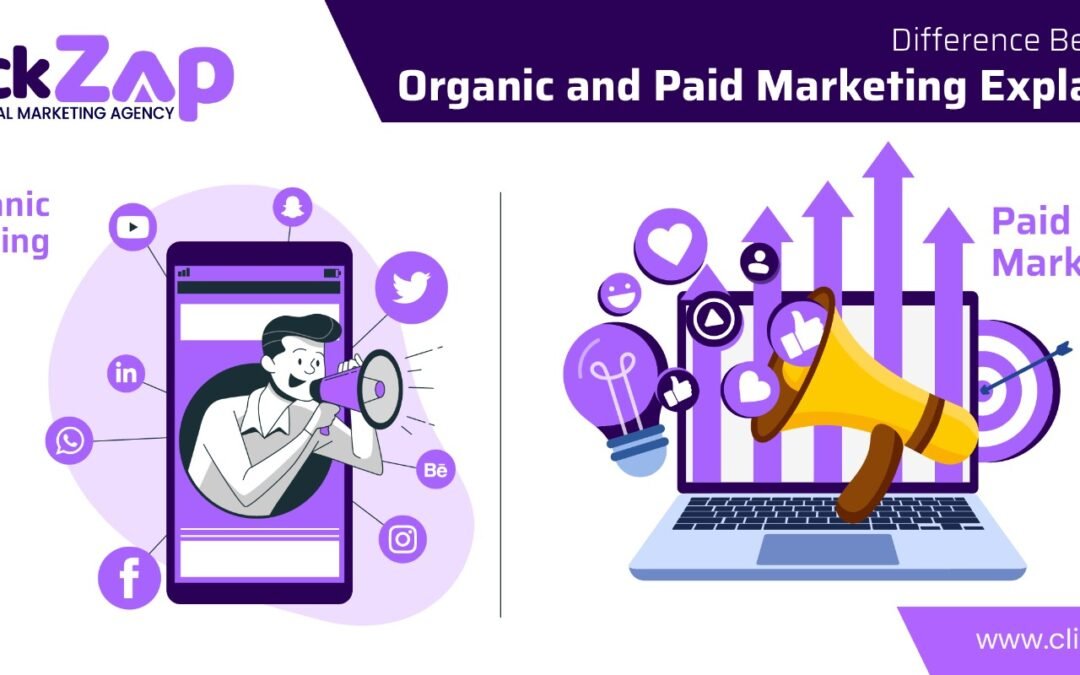In today’s digital landscape, data-driven decisions are the key to success. Understanding how visitors interact with your website can help refine your marketing approach, optimize conversions, and improve audience targeting. This is where Google Analytics for Marketing plays a crucial role.
By leveraging Google Analytics for Marketing, businesses can track valuable insights about their audience, measure the effectiveness of their campaigns, and identify areas for improvement. In this guide, we’ll explore how Google Analytics for Marketing can help you improve marketing strategy, increase traffic, and enhance overall performance.
At ClickZap IT, we understand the importance of data-driven marketing. That’s why we’re breaking down everything you need to know about using Google Analytics for Marketing effectively.
Why Google Analytics for Marketing is Essential
Before diving into advanced tactics, let’s understand why Google Analytics for Marketing is a must-have tool for any business:
- It provides website traffic analysis to track where visitors come from and how they engage with your site.
- It helps with Google Analytics reports that showcase trends and patterns in audience behavior.
- It offers customer behavior insights to refine content and optimize user experience.
- It supports conversion rate optimization by identifying barriers to conversions.
- It enables marketing performance tracking by evaluating the effectiveness of different campaigns.
Now, let’s explore how to maximize the power of Google Analytics for Marketing.
1. Setting Up Google Analytics for Effective Marketing Insights
To get started, follow these steps:
- Create a Google Analytics Account – Sign up and add your website for tracking.
- Install the Tracking Code – Embed the Google Analytics script in your website’s header.
- Enable Google Analytics 4 (GA4) – The latest version offers advanced AI-driven insights.
- Set Up Goals and Conversions – Define key actions such as purchases, form submissions, or downloads.
- Integrate with Other Marketing Tools – Connect Google Analytics for Marketing with Google Ads, Search Console, and CRM software.
Once set up, you can start collecting data and generating Google Analytics reports for better decision-making.
2. Analyzing Website Traffic for Smarter Marketing
One of the primary benefits of Google Analytics for Marketing is its ability to provide detailed website traffic analysis.
Key Reports for Understanding Website Traffic:
- Acquisition Report: Determines which channels (organic, paid, social, referral) bring in the most visitors.
- Behavior Flow Report: Shows how users navigate through your website.
- Landing Page Report: Identifies the top-performing pages that attract visitors.
By analyzing these Google Analytics reports, marketers at ClickZap IT can adjust strategies to focus on high-performing channels and eliminate underperforming ones.
3. Understanding Customer Behavior for Personalized Marketing
A major advantage of Google Analytics for Marketing is access to customer behavior insights. This data helps businesses tailor their messaging, improve content, and enhance user experience.
Key Metrics to Track:
- Session Duration: Measures how long users stay on your website.
- Bounce Rate Reduction: High bounce rates indicate that visitors are leaving without interacting.
- Exit Pages: Shows where users are dropping off.
At ClickZap IT, we use customer behavior insights to refine our content marketing strategies, ensuring that users engage with relevant and valuable content.
4. Optimizing Conversion Rates with Google Analytics
Boosting sales and lead generation requires conversion rate optimization. Google Analytics for Marketing provides powerful tools to optimize your conversion rates.
Steps for Conversion Rate Optimization:
- Set Up Goals: Track form submissions, purchases, or video views.
- Use Funnel Visualization: Identify drop-off points in your sales funnel.
- A/B Testing: Test different CTAs, layouts, and content to see what performs best.
- Check Multi-Channel Attribution: Determine which channels contribute to conversions.
With conversion rate optimization, businesses can refine their strategies to drive more sales.
5. Audience Segmentation for Targeted Marketing
Understanding different audience segments helps businesses create personalized marketing campaigns.
How Audience Segmentation Works in Google Analytics:
- Demographics Data: Age, gender, and interests of users.
- Geographic Data: Location of your visitors.
- Behavioral Data: Frequency of visits and interactions with content.
Using audience segmentation, businesses can refine their targeting for SEO and PPC tracking, ensuring that they reach the right customers.
- Leveraging Google Analytics for SEO and PPC Tracking
A strong marketing strategy includes both organic and paid efforts. Google Analytics for Marketing helps track:
- SEO Performance: Which keywords and pages are driving traffic.
- PPC Campaigns: ROI and effectiveness of Google Ads campaigns.
- Organic vs. Paid Traffic: Understanding where your audience comes from.
By integrating SEO and PPC tracking, businesses can allocate their marketing budgets more effectively.
7. Using Google Analytics Dashboard for Real-Time Decision Making
Marketers need access to real-time data for quick adjustments. The Google Analytics dashboard provides:
- Customizable widgets to track key metrics.
- Real-time reports to monitor website activity.
- Performance comparisons to analyze trends over time.
By using the Google Analytics dashboard, businesses can make data-driven decisions for better marketing outcomes.
- Enhancing User Experience (UX) with Google Analytics
User experience plays a crucial role in marketing success. Google Analytics for Marketing helps businesses refine UX by:
- Identifying slow-loading pages.
- Understanding navigation issues.
- Improving mobile responsiveness.
By focusing on user experience (UX) in SEO, businesses can ensure a seamless website experience that keeps visitors engaged.
- Implementing Structured Data for Better Insights
Adding structured data and schema markup helps Google understand website content better. Google Analytics for Marketing can track the impact of structured data on:
- Rich snippets and featured results.
- Click-through rates (CTR).
- Search engine rankings.
By incorporating structured data and schema markup, businesses can boost their SEO performance.
10. Making Data-Driven Decisions for Marketing Success
Finally, the power of Google Analytics for Marketing lies in data-driven decision-making. Businesses can:
- Predict future trends with Google Analytics reports.
- Optimize campaigns based on marketing performance tracking.
- Adjust strategies based on customer behavior insights.
By using Google Analytics for Marketing, businesses can transform their digital marketing efforts and drive higher revenue.
Final Thoughts
Google Analytics for Marketing is an essential tool for modern businesses. Whether you’re looking to improve marketing strategy, enhance conversion rate optimization, or gain deeper customer behavior insights, Google Analytics provides the data you need to succeed.
At ClickZap IT, we specialize in helping businesses harness the power of Google Analytics for Marketing to drive growth. By focusing on data-driven decision-making, SEO and PPC tracking, and audience segmentation, we ensure that your marketing efforts lead to real results.
Are you ready to elevate your marketing game? Start using Google Analytics for Marketing today and watch your business thrive!





0 Comments